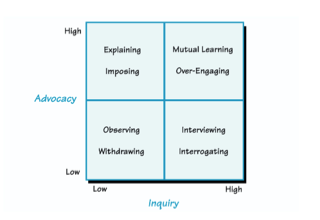Improve the quality of the “relational space” you create together
“[T]ransforming systems is ultimately about transforming relationships among people who shape those systems.” —The Dawn of System Leadership
In the face of today’s complex challenges, many of us feel overwhelmed and helpless. It is daunting to acknowledge that, through our collective actions, we end up creating results that no one wants:
- Educational institutions that frustrate both teachers and students, parents and employers
- Healthcare systems that fall short of providing wellness
- Climate change and the resulting environmental disasters
- Vast and growing inequality, and so on
Numerous collaborative initiatives have taken on these challenges but have made little headway—in part because they failed to foster collective leadership within and across the collaborating organizations.
Making real traction on these kinds of issues requires improving the quality of the “relational space” people create together, that is, the shared norms, values, and practices for how they interact. As a leader, together with members of your team, you can learn how to:
- Understand how your beliefs may limit what you see and hear
- Set aside the assumptions you carry into conversations
- Participate in deep, shared reflection to hear different perspectives and grasp others’ experiences of reality
Peter Senge, Hal Hamilton, and John Kania describe these practices as “an essential doorway for building trust where distrust had prevailed and for fostering collective creativity” (The Dawn of System Leadership).
There are many tools and approaches for strengthening the quality of your interactions with others, by improving how you:
- Listen
- Give feedback
- Engage in conversation
- Reflect together
This investment in relationships is at the heart of effective systems change—and any initiative to make progress on complex, adaptive problems that neglects to focus attention here will invariably falter.
Send us your recommendations for practices and tools.
Deep Listening
In today’s fast-paced, distraction-laden world, deep listening is a skill that may not come naturally to you or your team. Fortunately, through committed practice, you can learn to create a space for other people to voice their thoughts. Listening in this way is more than just hearing—it involves actively discovering what the other person is trying to convey. When someone is able to express themselves openly and feels heard, it can lead to a more authentic sense of connection.
Deep Listening
Advocacy and Inquiry
Most conversations involve a flow of advocacy and inquiry: Both participants advocate for their own positions and inquire into the other party’s thinking. But when the stakes are high or tensions mount, people tend to rely more heavily on advocacy—which reduces the possibility for shared learning. There are tips you can follow to improve the balance of advocacy and inquiry—and the quality of collective learning—in your conversations.

How to Balance Advocacy and Inquiry
The Conversation Meter

The consulting firm Conversant has developed a free tool for helping people:
- Diagnose when conversations are on or off track
- Predict likely outcomes if the conversation continues as it is
- Prescribe potential new and beneficial responses to improve outcomes
They provide worksheets and other material to guide you in improving the quality of your conversations.
The Conversation Meter
Dialogue Interviews
Dialogue Interviews are a tool for gathering perspectives from people from throughout a complex system. Reos Partners, a global consulting firm that uses this technique, describes them in this way: “Dialogue Interviews are in-depth conversations with concerned people throughout a complex system. Rarely do people feel so thoroughly heard.
Dialogue Interviews
Paired Walks
Most of the time we’re interacting with people on shared projects, we’re sitting—which is an apt symbol for how we often remain stuck in our positions. In their workshops, consulting firm Reos Partners shifts this dynamic by having people pair up with someone who thinks differently from them and walk outside while discussing a guiding question. The result: Participants connect with nature, generate energy and focus, experience forward movement through their bodies, and deepen their shared reflection on the theme.
Paired Walks